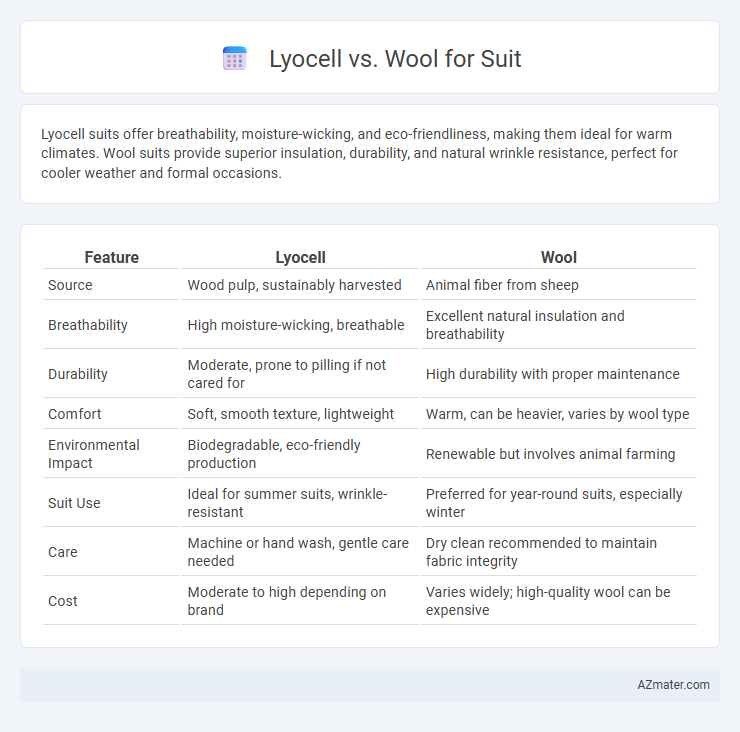Lyocell suits offer breathability, moisture-wicking, and eco-friendliness, making them ideal for warm climates. Wool suits provide superior insulation, durability, and natural wrinkle resistance, perfect for cooler weather and formal occasions.
Table of Comparison
| Feature | Lyocell | Wool |
|---|---|---|
| Source | Wood pulp, sustainably harvested | Animal fiber from sheep |
| Breathability | High moisture-wicking, breathable | Excellent natural insulation and breathability |
| Durability | Moderate, prone to pilling if not cared for | High durability with proper maintenance |
| Comfort | Soft, smooth texture, lightweight | Warm, can be heavier, varies by wool type |
| Environmental Impact | Biodegradable, eco-friendly production | Renewable but involves animal farming |
| Suit Use | Ideal for summer suits, wrinkle-resistant | Preferred for year-round suits, especially winter |
| Care | Machine or hand wash, gentle care needed | Dry clean recommended to maintain fabric integrity |
| Cost | Moderate to high depending on brand | Varies widely; high-quality wool can be expensive |
Introduction to Lyocell and Wool
Lyocell, a sustainable fabric derived from wood pulp, offers lightweight breathability and moisture-wicking properties ideal for suits in warm climates. Wool, known for its natural insulation and durability, provides excellent temperature regulation and wrinkle resistance, making it a timeless choice for formal attire. Comparing Lyocell and wool highlights their distinct advantages in comfort and performance for tailored suits.
Overview of Suit Fabric Choices
Lyocell suits offer a lightweight, breathable option made from sustainable wood pulp fibers, ideal for warm climates and eco-conscious consumers. Wool, renowned for its natural insulation and durability, provides superior wrinkle resistance and moisture-wicking properties, making it the traditional choice for year-round wear. Both fabrics balance comfort and style, with lyocell emphasizing softness and sustainability, while wool excels in resilience and temperature regulation.
What is Lyocell?
Lyocell is a sustainable fabric made from wood pulp, known for its breathability, moisture-wicking properties, and smooth texture, making it ideal for comfortable suits. Compared to wool, Lyocell offers a lighter, cooler alternative that resists wrinkles and dries quickly, enhancing wearability in warmer climates. Its eco-friendly production process uses non-toxic solvents and recycles water, appealing to environmentally conscious consumers seeking stylish yet sustainable suit fabrics.
What is Wool?
Wool, a natural fiber obtained from sheep, is prized for its excellent insulation, moisture-wicking properties, and durability, making it a traditional choice for suits. Its ability to regulate temperature keeps wearers warm in winter while remaining breathable in warmer conditions, enhancing comfort throughout the day. Wool fibers naturally resist wrinkles and creases, ensuring suits maintain a polished and refined appearance even after extended wear.
Breathability and Comfort Comparison
Lyocell suits offer superior breathability due to their moisture-wicking properties and natural fiber structure, making them ideal for warm climates. Wool suits provide excellent insulation and temperature regulation while maintaining breathability through their natural crimped fibers, which trap air for comfort in various conditions. Both fabrics ensure comfort, but Lyocell excels in moisture management, whereas wool adapts better to fluctuating temperatures.
Durability and Longevity
Lyocell suits offer moderate durability with their cellulose-based fibers resistant to wear and moisture, making them suitable for everyday use but prone to pilling over time. Wool suits outperform Lyocell in longevity due to their natural elasticity and resilience, providing superior wrinkle resistance and the ability to retain shape after years of use. Premium wool fabrics like Merino ensure enhanced durability, making them the preferred choice for long-lasting, high-quality suits.
Sustainability and Environmental Impact
Lyocell suits offer superior sustainability compared to wool due to their production from renewable wood pulp using a closed-loop process that recycles water and solvents, minimizing environmental pollution. Wool, while natural and biodegradable, often involves intensive land use, methane emissions from sheep, and significant water consumption, contributing to a larger carbon footprint. Choosing lyocell over wool reduces reliance on animal agriculture and lowers greenhouse gas emissions, supporting eco-friendly fashion choices.
Maintenance and Care Requirements
Lyocell suits require gentle washing with mild detergents and air drying to prevent fiber damage, making maintenance relatively simple compared to wool. Wool suits demand careful dry cleaning to maintain fabric integrity and avoid shrinkage, with occasional brushing to remove surface dirt and moisture control to prevent mildew. Proper storage in breathable garment bags is essential for both fabrics to extend their lifespan and preserve appearance.
Pricing and Accessibility
Lyocell suits generally offer more affordable pricing compared to wool, making them a budget-friendly option for sustainable fashion enthusiasts. Wool suits, known for their natural insulation and resilience, often command higher prices due to the cost of raw materials and traditional manufacturing processes. Lyocell's accessibility is increasing with advancements in textile technology and eco-friendly production, while wool remains widely available through established mill sources and tailored suit retailers.
Which is Better for Your Suit: Lyocell or Wool?
Lyocell offers a lightweight, breathable, and eco-friendly option for suits, ideal for warm climates and those seeking sustainable fabrics. Wool provides superior insulation, natural wrinkle resistance, and durability, making it a classic choice for year-round wear, especially in cooler temperatures. Choosing between lyocell and wool ultimately depends on climate, comfort preferences, and sustainability priorities for your suit.

Infographic: Lyocell vs Wool for Suit
 azmater.com
azmater.com